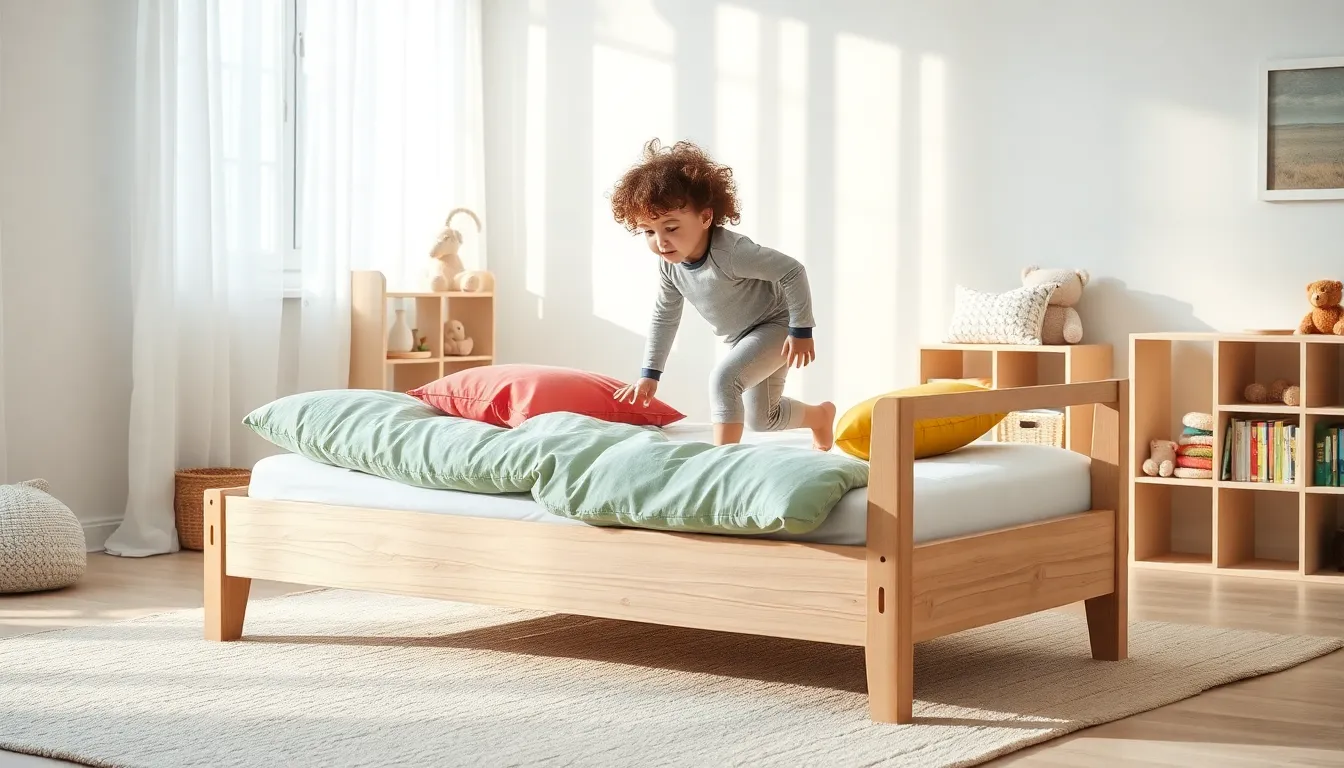Imagine a world where toddlers call the shots about their sleep, crazy, right? But with Montessori beds, that dream can become a reality. These beds aren’t just furniture: they’re an invitation to adventure, a pathway to independence, and a comfortable haven for your little one. Ready to leap into the magical realm of Montessori beds? Buckle up. We’re diving into how these unique beds can transform your child’s sleep experience while keeping safety and style in mind.
Table of Contents
ToggleUnderstanding Montessori Philosophy

At the core of a Montessori education lies the idea that encouraging independence is essential for a child’s growth. This philosophy extends to how children sleep, particularly through the use of Montessori beds.
The Importance Of Freedom And Independence
Montessori isn’t just about hands-on learning: it’s about respecting a child’s natural instincts and giving them the freedom to explore. When children choose their own bedtime routines, including when to get in and out of their beds, they develop a sense of autonomy. With Montessori beds, parents can rest easy knowing their toddlers are taking the reins, rather than waiting for a grown-up to lift them in and out.
How Montessori Beds Promote Development
These beds are designed to foster physical independence. By being low to the ground, Montessori beds make it simple for toddlers to climb in and out, so enhancing their gross motor skills. It’s like a tiny trampoline that helps little ones practice balance and coordination, just without the bouncing and falling, ideally. As they practice these skills, they also find confidence in movement. A win-win situation, wouldn’t you say?
Types Of Montessori Beds Available
When it comes to selecting the perfect Montessori bed, variety takes center stage. Parents have options suited to their families’ needs and aesthetics.
Floor Beds
Floor beds are the quintessential Montessori choice. They lie directly on the floor, allowing children easy access without the risk of a dramatic tumble. Plus, they enable toddlers to move freely, which promotes exploration and helps them feel in control of their sleep space. Many parents find that their children are more likely to settle in when they can navigate their environment at will.
Loft Beds
For those looking to conserve space, the loft bed is a fantastic choice. These beds create a fun elevated sleeping area while allowing for play or storage underneath. Just imagine your toddler’s excitement at having their own “clubhouse” for sleep. But, it’s crucial to ensure your little one is developmentally ready for this option. Safety rails can also offer peace of mind as they climb up to their cozy nook.
Transition Beds
Transition beds serve as a bridge between a crib and a full-sized bed. These beds often include features that make the switchover smooth and easy, letting your child feel a sense of ownership over their sleeping arrangements. Whether they’re offered in a toddler-friendly design or adjustable for future growth, these adaptable sleeping arrangements can accompany your youth into early childhood.
Choosing The Right Montessori Bed
Picking the right Montessori bed can feel like searching for a unicorn, but without a reliable map, it can get tricky. Fear not, for here are some key considerations.
Size And Space Considerations
First, assess the available space in the room. A floor bed might work best in a smaller area, while loft beds can save floor space and offer room for creativity beneath. Measure the dimensions carefully, ensuring the bed fits snugly without overwhelming the room.
Safety Features To Look For
Safety should be top of mind when selecting any bed. Look for rounded edges, sturdy construction, and the height of the bed. Make sure it’s low enough that if your little one rolls out in the night, it’s a soft landing. Also, consider incorporating safety rails for beds high off the ground.
Aesthetic And Design Aspects
Aesthetic appeal isn’t just for parents, it matters to little ones too. Montessori beds come in various designs and finishes, so consider what complements the room’s decor. Opt for natural materials, wood in particular, because they bring warmth into the space, making it cozy and inviting.
Setting Up A Montessori Sleep Environment
A bed is just one part of the equation. Creating a Montessori-inspired sleep environment can elevate the entire experience for toddlers.
Creating A Calm And Inviting Atmosphere
To set the stage, think about the ambiance. A calm and serene atmosphere promotes relaxation. Soft lighting, comfortable bedding, and a few gentle toys nearby can help make the space feel welcoming. Consider incorporating blackout curtains to keep harsh light from disrupting nap times.
Incorporating Natural Materials
Natural materials, like wood and cotton, not only look good but also feel good. They support various sensory experiences while keeping the environment healthy. Scents of lavender from essential oils may also help foster a tranquil sleeping area.
Establishing Sleep Routines
Routines play a significant role in a child’s ability to settle down. Reading a story, practicing deep breathing, or singing gentle lullabies can make bedtime less daunting. These practices contribute to a natural routine that fosters independence and comfort when it’s time for sleep.


